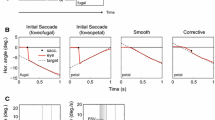Summary
Saslow and others have shown that the latency of foveating saccades can be altered by changing the offset time of the current fixation point relative to the onset of the peripheral target. Whether anticipatory saccades contributed to these results was not known. By the criteria of direction error and amplitude error the minimum latency for visually guided saccades is 110–130 ms for three subjects and 160 ms for a longer latency subject. Excluding anticipatory responses did not eliminate offset-onset effects. The genesis of express saccades and the role of higher neural levels is discussed.
Similar content being viewed by others
References
Becker W (1972) The control of eye movements in the saccadic system. Bibl Ophthalmol 82: 233–243
Becker W, Jürgens R (1979) An analysis of the saccadic system by means of double-step stimuli. Vision Res 19: 967–983
Cohen ME, Ross LE (1977) Saccade latency in children and adults: effects of warning interval and target eccentricity. J Exp Child Psychol 23: 539–549
Cohen ME, Ross LE (1978) Latency and accuracy characteristics of saccades and corrective saccades in children and adults. J Exp Child Psychol 26: 517–527
Feinstein R (1970) Interactions of the horizontal and vertical eye movement systems. Ph.D. Thesis, University of Michigan
Findlay J (1981) Spatial and temporal factors in the predictive generation of saccadic eye movements. Vision Res 21: 347–354
Fischer B, Boch R (1983) Saccadic eye movements after extremely short reaction times in the monkey. Brain Res 260: 21–26
Fischer B, Ramsperger E (1984) Human express saccades: extremely short reaction times of goal directed eye movements. Exp Brain Res 57: 191–195
Fischer B, Ramsperger E (1986) Human express saccades: effects of randomization and daily practice. Exp Brain Res 64: 569–578
Hallett PE (1978) Primary and secondary saccades to goals defined by instructions. Vision Res 18: 1279–1296
Hallett PE (1986) Eye movements. In: Boff K et al. (eds) Handbook of preception and human performance. Vol I, Chapt 10. John Wiley & Sons, New York, pp 78–101
Hallett PE, Adams BD (1980) The predictability of saccadic latency in a novel voluntary oculomotor task. Vision Res 20: 329–339
Hallett PE, Lightstone AD (1976) Saccadic eye movements towards stimuli triggered by prior saccades. Vision Res 16: 99–106
Henson DB (1976) Investigation into corrective saccadic eye movements. Ph.D. Thesis, Indiana University
Horrocks A, Stark L (1964) Experiments on error as a function of response time in horizontal eye movements. M.I.T. Research Laboratory in Electronics Quarterly Research Report 72: 267–269
Judge SJ (1973) Temporal interaction between human voluntary saccades and rapid phases of optokinetic nystagmus. Exp Brain Res 18: 114–118
Lewis J, Dunlap W, Matteson H (1972) Perceptual latency as a function of stimulus onset and offset and retinal location. Vision Res 12: 1725–1731
Mayfrank L, Mobashery M, Kimmig H, Fischer B (1986) The role of fixation and visual attention in the occurrence of express saccades in man. Eur Arch Psychiat Neurol Sci 235: 269–275
Newman C (1971) An investigation of the human saccadic visual tracking system. Ph.D. Thesis, University of Rochester
Pease V, Sticht T (1965) Reaction time as a function of onset and offset stimulation of the fovea and periphery. Percept Mot Skills 20: 549–554
Reulen JPH (1984a) Latency of visually evoked saccadic eye movements. I. Saccadic latency and the facilitation model. Biol Cybern 50: 251–262
Reulen JPH (1984b) Latency of visually evoked saccadic eye movements. II. Temporal properties of the facilitation mechanism. Biol Cybern 50: 263–271
Rohrer WH, Sparks DL (1986) Chronic single unit recording and microstimulation studies of superior colliculus during express saccades. Abstract presented in July at Developments in Oculomotor Research meeting at Glenedon Beach, Oregon, USA
Ross L, Ross S (1980) Saccade latency and warning signals: stimulus onset, offset, and change as warning events. Percept Psychophys 27: 251–257
Saslow MG (1967) Effects of components of displacement-step stimuli upon latency for saccadic eye movement. J Opt Soc Am 57: 1024–1029
Steinman RM (1986) The need for an eclectic, rather than systems, approach to the study of the primate oculomotor system. Vision Res 26: 101–112
Woodworth R, Schlosberg H (1962) Experimental psychology, revised edition. Holt, Rinehart and Winston, New York, pp 28–30
Author information
Authors and Affiliations
Rights and permissions
About this article
Cite this article
Kalesnykas, R.P., Hallett, P.E. The differentiation of visually guided and anticipatory saccades in gap and overlap paradigms. Exp Brain Res 68, 115–121 (1987). https://doi.org/10.1007/BF00255238
Received:
Accepted:
Issue Date:
DOI: https://doi.org/10.1007/BF00255238




